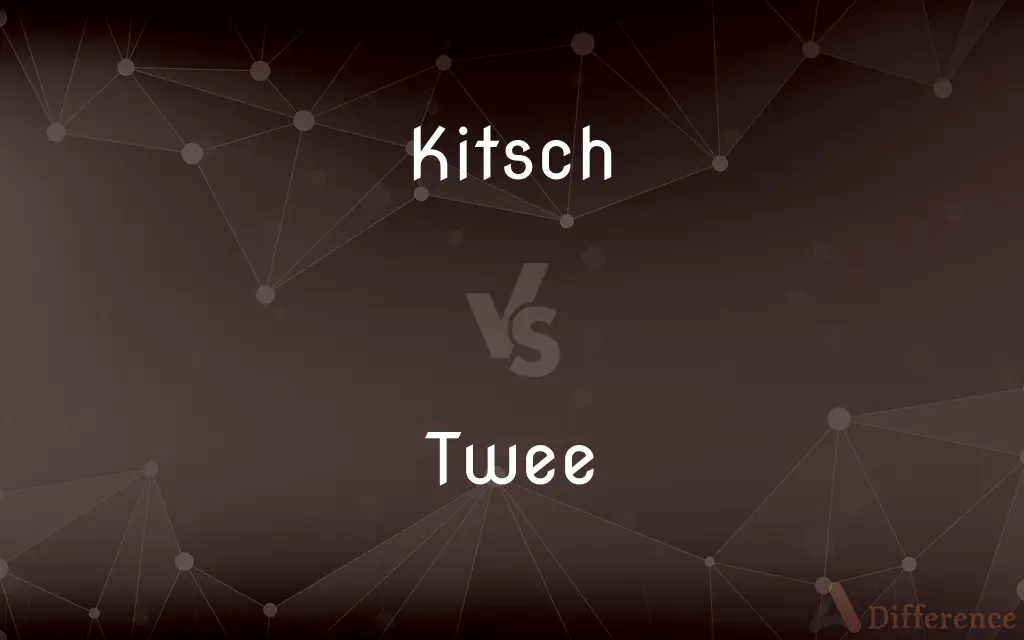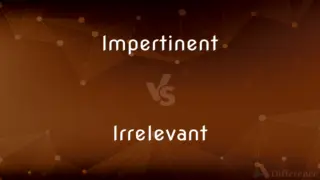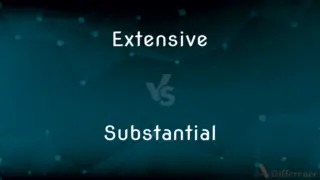Kitsch vs. Twee — What's the Difference?
By Tayyaba Rehman & Fiza Rafique — Updated on March 31, 2024
Kitsch involves art or objects that are considered to be in poor taste due to excessive garishness or sentimentality, while twee refers to things that are excessively or affectedly quaint, pretty, or sentimental.

Difference Between Kitsch and Twee
Table of Contents
ADVERTISEMENT
Key Differences
Kitsch is often associated with art, objects, or design considered excessively garish, sentimental, or in poor taste, reflecting a preference for what some may see as cultural trash. This aesthetic can embrace irony and nostalgia, often celebrating the gaudy or the overly sentimental. It's a form of expression that can be both celebrated and critiqued for its boldness and lack of subtlety. Twee, on the other hand, is characterized by its affectation of quaintness, sweetness, or sentimentality, often in a way that seems excessive or forced. Unlike kitsch, which can encompass a wide range of tastes and styles, twee specifically denotes a kind of innocence and cutesiness that appeals to a particular sensibility, often associated with indie pop culture and vintage fashion.
While kitsch is broad and can include anything from velvet Elvis paintings to plastic pink flamingos, celebrating mass culture’s less sophisticated side, twee focuses on a deliberate naivety and endearing quality in small, often handmade items or indie music. Both styles offer a critique of mainstream aesthetic values, but they do so from different angles. Kitsch challenges these norms by elevating the lowbrow and often ironic, whereas twee embraces a sincere and unabashed sweetness.
Kitsch’s appeal often lies in its irony and the joy found in openly embracing what is traditionally considered bad taste, serving as a form of cultural commentary. It's about reclaiming and appreciating the value in objects and styles that mainstream culture might dismiss. Twee, in contrast, seeks charm through earnestness and the deliberate cultivation of a nostalgic, innocent aesthetic. It’s less about irony and more about creating a cozy, whimsical world.
Kitsch has a broader cultural impact, influencing not only art and design but also fashion and cinema, making bold statements through its embrace of the extravagant and the excessive. It reflects a complex relationship with cultural norms, often used to question or subvert societal tastes. Twee, while also influential in these areas, tends to be more focused on personal expression and the creation of intimate, sentimental experiences. It represents a quieter rebellion against modern cynicism and detachment.
Comparison Chart
Definition
Art or objects in poor taste due to excessive garishness or sentimentality.
Excessively or affectedly quaint, pretty, or sentimental items or styles.
ADVERTISEMENT
Key Characteristics
Irony, nostalgia, celebration of lowbrow culture.
Innocence, earnestness, charm, focus on handmade and vintage.
Cultural Impact
Broad, affecting art, design, fashion, and cinema; often makes bold statements.
More focused on personal expression and intimate experiences; a quiet rebellion.
Appeal
Joy in embracing what is considered bad taste, cultural commentary.
Charm through earnestness and nostalgia, creating a whimsical world.
Examples
Velvet Elvis paintings, plastic pink flamingos.
Handmade items, indie music, vintage fashion.
Compare with Definitions
Kitsch
Aesthetic that celebrates exaggerated and tacky styles.
The diner's decor, filled with neon signs and retro posters, embraced a kitsch aesthetic.
Twee
Excessively sweet, quaint, or sentimental in nature.
The cafe's decor, with pastel colors and floral patterns, was criticized for being too twee.
Kitsch
Kitsch involves the appreciation of items that are not traditionally seen as 'artistic' or 'tasteful.'
The film festival featured kitsch B-movies known for their campy plots and over-the-top performances.
Twee
Associated with an indie or alternative sensibility that values innocence and whimsy.
The indie pop band's music is known for its twee melodies and whimsical lyrics.
Kitsch
A cultural product that appeals because of its bad taste or ironic value.
Some people collect vintage kitsch holiday decorations for their ironic appeal.
Twee
Affecting a deliberate prettiness or quaintness.
She enjoys crafting twee handmade greeting cards for her friends.
Kitsch
Art or design considered in poor taste because of excessive garishness or sentimentality.
A velvet painting of dogs playing poker can be seen as kitsch due to its gaudy style.
Twee
Often seen as a cultural and aesthetic choice opposing modern cynicism.
Their wedding featured homemade decorations and a folk band, embracing a twee sensibility.
Kitsch
Anything considered to be in poor taste but enjoyed in a knowing and ironic way.
Wearing a brightly colored, oversized Hawaiian shirt can be an example of kitsch fashion.
Twee
Emphasizing a nostalgic or vintage charm.
He collected vintage toys and furniture to give his apartment a twee aesthetic.
Kitsch
Kitsch ( KITCH; loanword from German) is a term applied to art and design that is perceived as naïve imitation, gratuitous, or of banal taste.According to early critical theory, kitsch provides immediate gratification based on contrived sentiment. Behind a culture industry, kitsch works to pacify difference, or social complexity, and engender a psychological interdependence with homogenous consumerism.The avant-garde opposed kitsch as melodramatic and superficial affiliation with the human condition and its natural standards of beauty.
Twee
Overly precious or nice.
Kitsch
Pieces of art or other objects that appeal to popular or uncultivated taste, as in being garish or overly sentimental.
Twee
Overly quaint, dainty, cute or nice.
Kitsch
Art, decorative objects, and other forms of representation of questionable artistic or aesthetic value; a representation that is excessively sentimental, overdone, or vulgar.
Twee
Affectedly dainty or refined
Kitsch
Of art and decor: of questionable aesthetic value; excessively sentimental, overdone or vulgar.
Kitsch
Art in pretentious bad taste
Kitsch
Of a display that is tawdry or vulgar
Common Curiosities
Is it possible for an object to be both kitsch and twee?
While kitsch and twee have distinct characteristics, some objects might blend both, especially if they are ironic yet earnestly quaint.
Why do people embrace twee aesthetics?
People embrace twee aesthetics for its charm, innocence, and the sense of warmth and nostalgia it evokes.
How does twee differ from kitsch in its cultural significance?
Twee represents a more focused expression of quaintness and nostalgia, often opposing modern cynicism, whereas kitsch embraces irony and lowbrow culture broadly.
What role does irony play in kitsch?
Irony is central to kitsch, as it often involves a knowing appreciation of something considered in poor taste.
What defines something as kitsch?
Kitsch is defined by its excessive garishness, sentimentality, or ironic appeal, often celebrating what mainstream culture considers in poor taste.
What is the appeal of kitsch culture?
The appeal of kitsch culture lies in its celebration of the unconventional and the ironic enjoyment of cultural products considered in poor taste.
How is twee reflected in music?
Twee is reflected in music through its whimsical, innocent melodies and lyrics, often found in indie pop genres.
What makes an object or style "twee"?
An object or style is considered twee if it is excessively quaint, sweet, or sentimental, often with a nostalgic or handmade charm.
Can kitsch be considered art?
Yes, kitsch can be considered art, especially when it is used to make a statement about aesthetics or cultural values.
Can twee be seen as a form of escapism?
Yes, twee can be seen as a form of escapism, offering a return to innocence and simplicity in a complex world.
What kinds of objects are considered kitsch?
Objects considered kitsch include mass-produced decorations, tacky souvenirs, and gaudy art, among others.
How has kitsch influenced modern design?
Kitsch has influenced modern design by challenging conventional notions of taste and incorporating irony and nostalgia into contemporary aesthetics.
Is kitsch always negative?
No, kitsch is not always negative; it can be embraced positively for its humor, irony, and cultural commentary.
How do kitsch and twee approach nostalgia differently?
Kitsch approaches nostalgia with irony and a celebration of lowbrow culture, while twee approaches it with earnestness and a longing for simplicity.
Why is twee popular in certain subcultures?
Twee is popular in certain subcultures for its association with indie culture, its emphasis on authenticity, and its counter to mainstream cynicism.
Share Your Discovery

Previous Comparison
Impertinent vs. Irrelevant
Next Comparison
Extensive vs. SubstantialAuthor Spotlight
Written by
Tayyaba RehmanTayyaba Rehman is a distinguished writer, currently serving as a primary contributor to askdifference.com. As a researcher in semantics and etymology, Tayyaba's passion for the complexity of languages and their distinctions has found a perfect home on the platform. Tayyaba delves into the intricacies of language, distinguishing between commonly confused words and phrases, thereby providing clarity for readers worldwide.
Co-written by
Fiza RafiqueFiza Rafique is a skilled content writer at AskDifference.com, where she meticulously refines and enhances written pieces. Drawing from her vast editorial expertise, Fiza ensures clarity, accuracy, and precision in every article. Passionate about language, she continually seeks to elevate the quality of content for readers worldwide.














































